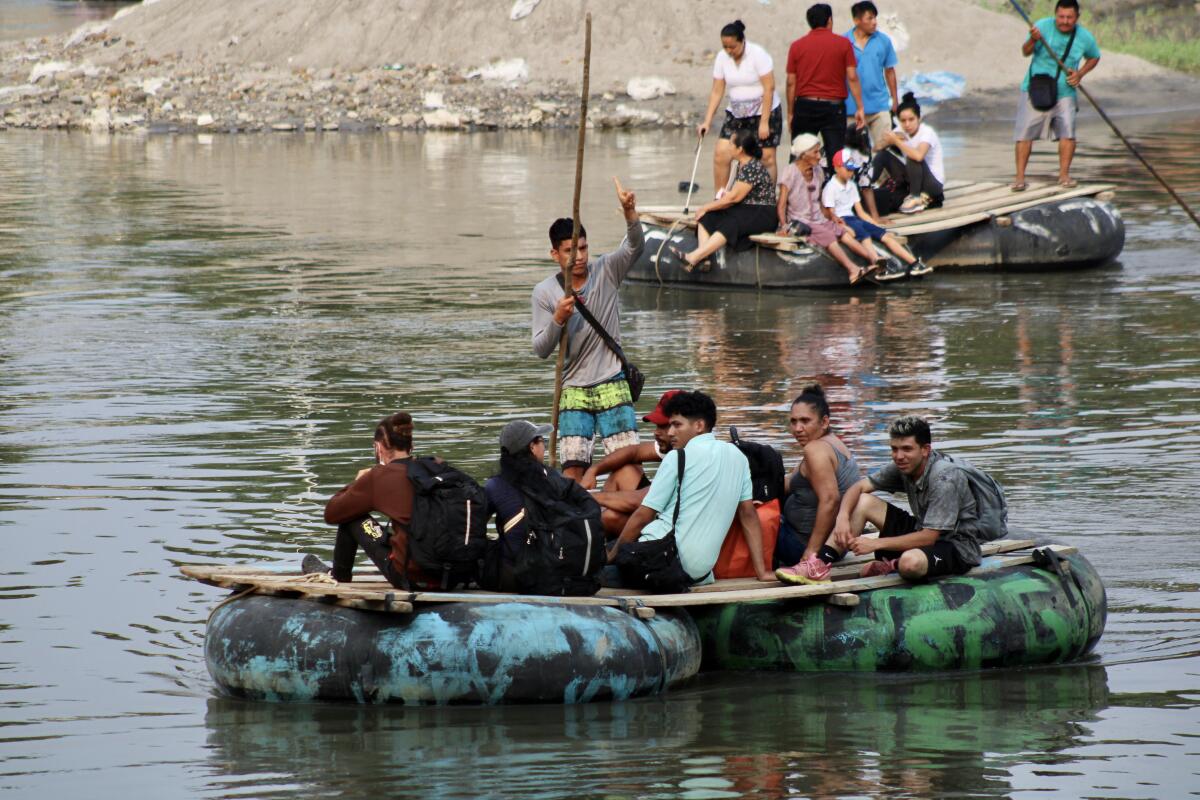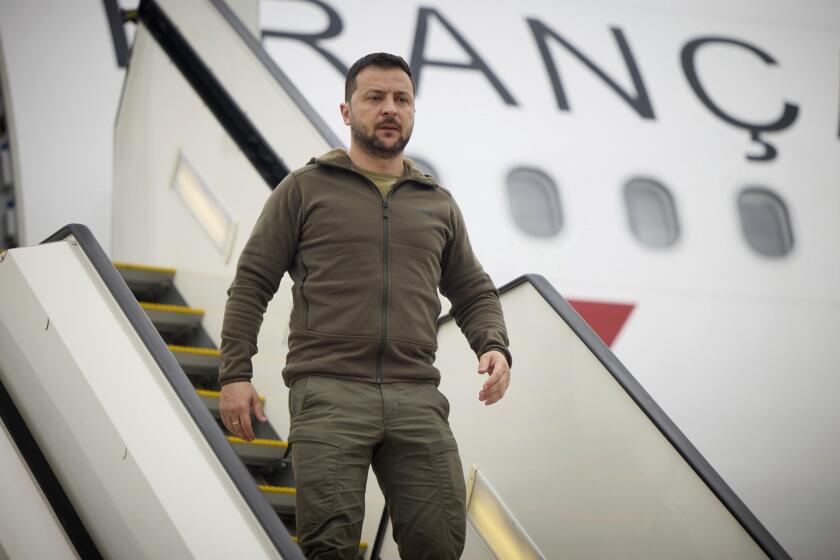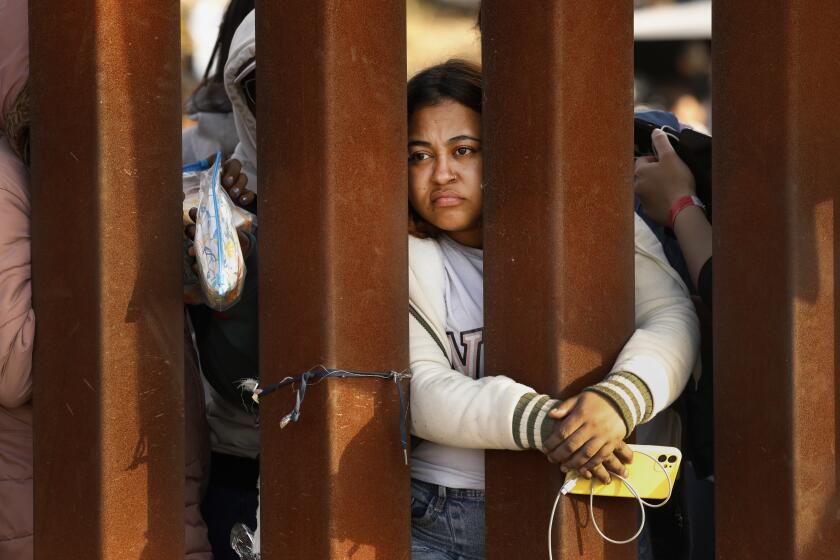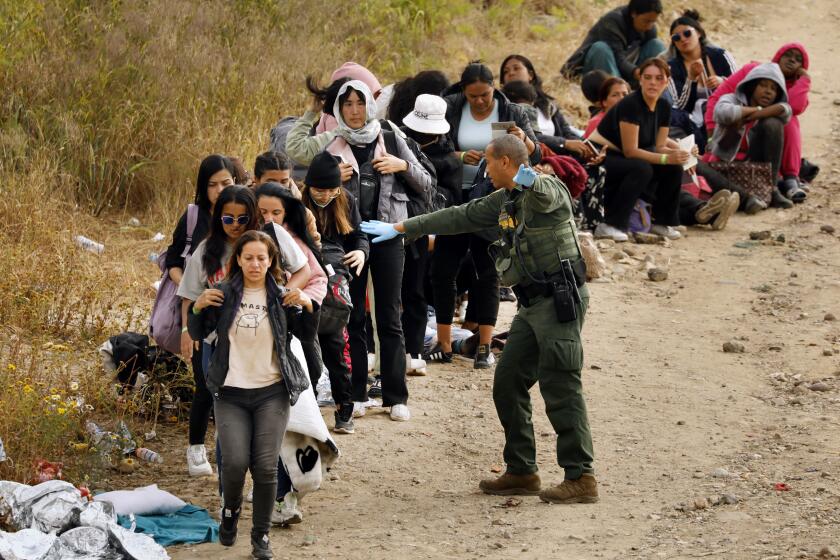âWe want to be Americansâ: Migrants flow through Mexicoâs southern border after Title 42âs end

CIUDAD HIDALGO, Mexico â Dawn had barely illuminated the turbid waters of the Rio Suchiate at the border with Guatemala when the boatmen â plunging long poles in the muck to propel their vessels â began to transport their daily load: a polyglot contingent of migrants from across the globe. All had a common destination: the United States.
âWe didnât make it to America before the end of Title 42, but still we will continue forward,â declared FĂŠlix Bandres, 61, who led a church group of some two dozen Venezuelans, including women and children, crowded on the raft crafted of wooden planks secured to inflatable inner tubes from tractor tires. âIt is need, and the search of a better life, that is driving us.â
Officials in Washington assert that the numbers of illicit crossings along the U.S.-Mexico border have declined since the May 11 end of Title 42. The pandemic-era rule, put in place by the Trump administration and initially retained by the Biden White House, allowed the Border Patrol to turn back hundreds of thousands of migrants without affording them a chance to apply for political asylum or seek other relief from within the United States.
But here, some 1,000 miles from the Rio Grande, the chaotic scene is business as usual: Huge numbers of U.S.-bound migrants â mostly South and Central Americans, but also a mix of people from Africa, Asia and Europe â are making illegal crossings of the more than 500-mile border separating Mexico from Guatemala.
The river crossings pose a challenge for U.S. authorities navigating the post-Title 42 legal landscape.
The Biden administration, under intense political pressure to ease illicit migration at the U.S. border, warns that those crossing into the country illegally will be presumed ineligible for asylum and subject to deportation â or possibly prison. U.S. officials are encouraging migrants to seek appointments before reaching the country by using the glitchy CBP One mobile app.
Although he vowed the U.S. debt crisis would not overshadow meeting of worldâs wealthiest democracies, Biden returned to the theme on its final day.
It is not known how many migrants bound for the U.S. are entering the vast border zone between Guatemala and Mexico. Much of the stretch is composed of unpatrolled stretches of river, mountains and jungle. The area has historically been a transit corridor for migrants and contraband, from food and gasoline to illegal drugs.
One indication of the mass of humanity en route to the United States is the record numbers of migrants crossing the Darien Gap, the treacherous, 60-mile stretch of rainforest between Colombia and Panama. Migrants from South America, Africa, Asia and elsewhere regularly navigate terrain that was once considered nearly unpassable but has in recent years become one of the planetâs busiest migration corridors.
Between January and April, 127,687 migrants crossed the Darien, according to Panamanian authorities. There were fewer than 20,000 in the same period last year. Yet 2022 as a whole set an annual record of almost 250,000.
Venezuelans are the largest single group crossing the Darien, followed by Haitians. Almost all are seeking to make it here to Mexico, then to the United States.
Mexican authorities are reporting record numbers of applications for political asylum â almost 50,000 between January and April. Many asylum seekers say they plan to try and enter the United States once they receive legal refuge in Mexico â a status that will allow them to travel freely to the northern border.
Migrants waiting in border towns have increasingly turned to TikTok, Facebook, YouTube and other social media sites for updates on how the expiration of immigration policy Title 42 will affect them.
At the Suchiate River, Mexican immigration agents and National Guard troops watch impassively in the morning swelter as steady streams of migrants alight from the river boats. Passengers pay a crossing fare of about $1.50, and Mexican officials are making no effort to turn them back.
Wealthier migrants turn to the services of coyotes, or people-smugglers, who often use motorbikes to take them north. The smugglers usher their charges down dirt paths, past banana groves and into safe houses, as a prelude to the next leg of the journey.
But many canât afford those services. They make their way on their own, clambering up the river levee and onto the streets below, often dazed from the trip and the unforgiving, subtropical heat.
What fate awaits the migrants after crossing from Guatemala into Mexico remains a question mark.
With the end of Title 42, migrants say, Mexican authorities stopped issuing temporary safe conduct passes. Those documents had allowed many to make their way to the northern border largely unimpeded by Mexican immigration enforcement.
However, Mexican authorities appear to have shifted tactics: Although they are not being immediately turned back at the border, migrants are being stopped at checkpoints on roads radiating from the border zone. They are then bused to points in the Mexican interior, and it is unclear if they will ultimately be allowed to continue to the U.S. or face deportation or detention in Mexico.
Title 42, a public health policy invoked to control migration at the start of the COVID-19 pandemic, was lifted Thursday night.
Mexicoâs intention appears to be to disperse the swelling migrant population and avoid highly visible buildups in northern and southern border communities.
Mexico has been flying migrants at its northern border from at least one city, Reynosa, to the interior, according to a tweet last week from U.S. Customs and Border Protection. In addition, Mexican authorities have moved groups of stranded migrants from Mexico City to sites in the interior.
One prevalent rumor is that migrants transported to the interior are being asked to sign a declaration vowing to leave Mexico within three days. That is sufficient time to reach towns and cities along the U.S. border.
Mexican immigration officials did not return messages seeking comment.
Mexicoâs National Immigration Institute has been in disarray since a fire in March at a lockup in Ciudad JuĂĄrez in which 40 migrants perished. The agencyâs director is facing criminal charges for negligence, and the institute has temporarily shut down all 33 of its detention centers, including six here in Chiapas state, along the border with Guatemala.
âWe really donât know whatâs going to happen next,â said Edward Kapulun, a native of Sierra Leone who was among some 150 migrants stuck at a litter-strewn camp outside the southern city of Tapachula, next to a Mexican immigration checkpoint. Agents had removed many northbound buses and taxis. âWe are just waiting here to find out.â
Among those marooned at camps next to checkpoints in recent days were people from Congo, Senegal, Afghanistan, China and other nations, though Venezuelans appeared to be the largest single group.
Many fear being kidnapped or robbed â with good reason. Last week, Mexican authorities rescued some 50 U.S.-bound migrants â mostly Venezuelans and Central Americans â who had been abducted from a bus in the north of the country.
A group of six African men at the makeshift camp outside Tapachula said they had paid $300 each to a taxi driver to take them to the U.S. border, some 1,000 miles away. Instead, the driver dropped them off at the checkpoint in Tapachula, about 30 miles from the Guatemalan frontier, and drove off with their cash.
Kapulun, 29, an electrical engineer who installed solar panels back home in Freetown, said he faced repression in Sierra Leone because of his sexual orientation. He said he plans to seek asylum in the United States.
Like others here, he flew to South America and made his way overland to Central America â crossing the Darien Gap â and later boarded buses and other transport through Central America before reaching Mexico.
A group of 21 Afghans was also stuck at the roadside camp, next to a fetid stream that many used to wash clothes. They said they were ethnic Hazaras, a mostly Shiite group that has been targeted by the Taliban and other militant Sunni factions. All had flown from Dubai to Brazil and made the overland journey of more than 4,000 miles to Mexico, mostly on buses.
âMy question is: How do we become Americans?â asked Nematullah Nikzad, 30, who said his family ran a clothing shop in Kabul. âUnder the Taliban, life is very hard for us now. We want to be Americans.â
His wife and three children remain in the Afghan capital, he said. He hopes to send for them once he is settled in the United States.
Eliana Parra, 48, from Venezuela was traveling with her granddaughters, ages 9, 7 and 4. They were headed to Indiana, she said, where her daughter, the girlsâ mother, has been living for a year.
âIt has been a very hard trip,â Parra said, recalling the trek through the Darien with the children. âBut my daughter said itâs time â our family needs to be together again.â
A group of six Chinese men and women said they were headed to Flushing, in the New York City borough of Queens. They had heard of a large Chinese community there. Communicating with a reporter through a translation app, one of the men, Yelong Yang, described their motivation.
âWe just think of Americaâs dream of freedom,â wrote Yang, 23. âWe want a better future in America.â
Special correspondents Liliana Nieto del RĂo, Juan de Dios GarcĂa Davish and MarĂa de JesĂşs Peters in southern Mexico and Cecilia SĂĄnchez in Mexico City contributed to this report.
More to Read
Sign up for Essential California
The most important California stories and recommendations in your inbox every morning.
You may occasionally receive promotional content from the Los Angeles Times.













